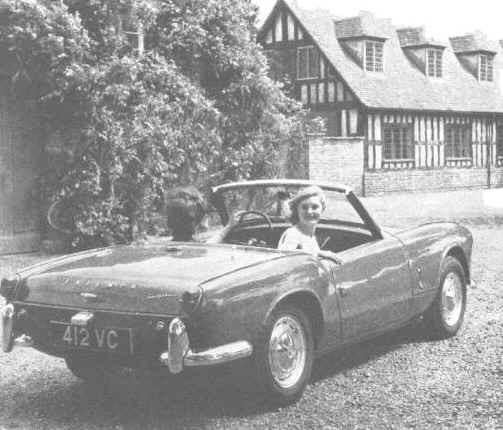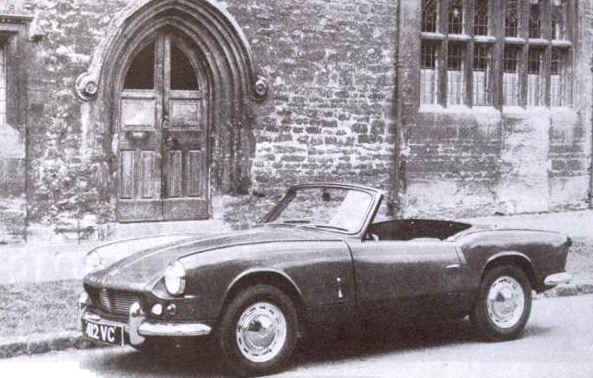
Triumph
Spitfire
BOLSTER
TESTS
Triumph
Spitfire 4 is a most exciting new, small sports.car. Capable of a
timed-both-ways maximum speed of 90 m.p.h.
and of covering the standing quarter-mile
in 19.4 seconds, it can also average under give -and-take conditions. It
therefore has all the performance characteristics that the average sports
car driver wants.
Yet,
the Spitfire is not only a sports car. With its winding windows raised and
hood up it becomes a luxurious coupe. The hood fabric never flaps, the
heater is efficient, and the sound level is quite low. Above all, it
has a turning circle of only 24 ft., which renders it an ideal town
and shopping car. With its extremely attractive appearance
and superior finish, this Triumph must be a good buy at a basic
price of £530 (P.T. extra).
The
foundation of the car is a narrow, backbone-type box-section frame,
similar to that of the Triumph Herald but shorter. There is independent
front suspension by wishbones and helical springs, with rack and pinion
steering and an anti-roll bar. Behind, the independent suspension is by
swing
axles with a transverse laminated spring, and a hypoid final drive unit is
mounted on the chassis.
The
four-cylinder engine has a capacity of 1,147 c.c. and a compression ratio
of 9 to 1. It has push-rod-operated overhead valves and twin carburetters,
developing a useful 63 b.h.p. at 5,750 r.p.m. With a weight of only 14
cwt. this is sufficient to guarantee a lively performance. The gear- box
has synchromesh on the upper three ratios and the open propeller shaft is
contained in a central tunnel.
The disc front brakes are included in the price, whereas they are optional extras on the Herald. The car is well equipped, a rev. counter being fitted as standard, but an oil

pressure
gauge would be appreciated by enthusiastic drivers. There is quite a
useful luggage boot and some space behind the seats, while the whole front
end opens up to reveal the engine and suspension, conferring a degree of
accessibility that is rare indeed, the power unit being unusually far
forward.
Even
with the hood up, the Spitfire is quite easy to enter through its large
doors. The fly-off hand brake is an appreciated feature and the gear lever
is well placed for easy operation. The steering column is arranged to
telescope in the event of a crash, and there are many other safety
features.
The clutch grips well and the getaway is rapid without any pattering of the rear wheels, but wheelspin is experienced in snow due to the weight distribution. The engine is very flexible indeed, permitting much of the work to be done on top gear, but third gives a full 70 m.p.h., encouraging very rapid ascents of the steeper hills. The gearchange is easy, the synchromesh being adequate for all but the most clumsy drivers. The gears are just audible, but the final drive is completely silent, a considerable engineering achievement.
The
engine is a very willing little unit, permitting 80 m.p.h. cruising with a
considerable reserve of power beneath the right foot. Exactly 90 m.p.h.
was achieved in both directions on the timed stretch, the car being closed
at the time. The exhaust is quiet, but the engine, while revving smoothly,
has just that suspicion of "hard- ness" that one expects of
sporting machinery.
As
this is strictly a two-seater, the suspension does not have to be
proportioned to carry rear passengers. In consequence, a more advantageous
angle has been chosen for the rear swing axles than in the case of the
Herald, which is of great benefit to the comering power. The Spitfire does
not oversteer until it is really forced into a comer, when the sliding of
the rear end is fully controllable. The ride is distinctly firm, but more
comfort is given over bad road surfaces than would be expected. The
insulation of road noise from the body is
very good
indeed.
The steering is quite light and unusually "quick", which is exactly as it should be in a sports car. The machine feels very controllable, is steady at speed, and has

